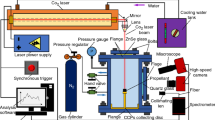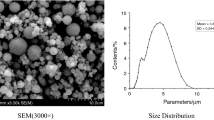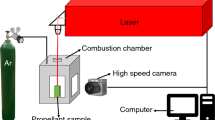Abstract
Since solid propellants can significantly increase the mobility, load, and range of missile weapons and equipment when used as a power source, energy performance is always the primary focus of solid propulsion technology development. This paper investigated differences in the agglomeration of aluminum (Al) and characteristics of the burning surface of nitrate ester plasticized polyether (NEPE) propellants and hydroxyl-terminated polybutadiene (HTPB) propellants. The experiments were conducted under a 0.1 MPa argon gas atmosphere using a high-speed camera combined with a telephoto microscope head (macro lens). In comparison with HTPB propellants, it was discovered that the agglomeration process of Al particle of NEPE propellants had two modes. Al aggregates exit the burning surface after growing into nearly spherical agglomerates in Mode A, which is comparable to HTPB propellants. Unique to NEPE propellants, Mode B is where the Al particles aggregate into massive coral-like structures. Three factors could account for this discrepancy. First, since NEPE propellants include less ammonium perchlorate (AP), the AP is less likely to form a pocket structure. It keeps the Al particles in a large "pocket" resembling the burning surface and provides advantages for their ability to aggregate. Second, NEPE propellants have a thicker molten layer on the burning surface. It has a capillary force impact on the Al particles on the burning surface and promotes interaction between Al particles. Finally, NEPE propellants create a clear skeleton layer on the burning surface that helps Al particles stay on the burning surface. A microscopic multi-flame combustion model was created to describe the makeup of the flame of NEPE propellants. It includes the AP unit flame, the CL-20-AP flame, the Al combustion flame, and the diffusion flame of the products of decomposition of each component. In this study, the existence of molten layer and skeleton layer on the burning surface of NEPE propellants was observed for the first time in experiments. It contributes to the understanding of the unique agglomeration behavior of aluminum particles of NEPE propellants and provides theoretical guidance for the directional regulation of aluminum particle agglomeration characteristics.















Similar content being viewed by others
References
LH Caveny RL Geisler RA Ellis TL Moore 2003 Solid rocket enabling technologies and milestones in the United States J Propul Power 19 1038 1066 https://doi.org/10.2514/2.6944
A Ambekar M Kim W-H Lee JJ Yoh 2017 Characterization of display pyrotechnic propellants: burning rate Appl Therm Eng 121 761 767 https://doi.org/10.1016/j.applthermaleng.2017.04.097
H Liu W Ao Q Hu P Liu S Hu L Liu Y Wang 2020 Effect of RDX content on the agglomeration, combustion and condensed combustion products of an aluminized HTPB propellant Acta Astronaut 170 198 205 https://doi.org/10.1016/j.actaastro.2020.01.038
Q-L Yan Z-W Song X-B Shi Z-Y Yang X-H Zhang 2009 Combustion mechanism of double-base propellant containing nitrogen heterocyclic nitroamines (II): the temperature distribution of the flame and its chemical structure Acta Astronaut 64 602 614 https://doi.org/10.1016/j.actaastro.2008.10.013
VP Sinditskii AN Chernyi VY Egorshev DV Dashko TK Goncharov NI Shishov 2019 Combustion of CL-20 cocrystals Combust Flame 207 51 62 https://doi.org/10.1016/j.combustflame.2019.05.039
UR Nair R Sivabalan GM Gore M Geetha SN Asthana H Singh 2005 Hexanitrohexaazaisowurtzitane (CL-20) and CL-20-based formulations (review) Combust Explos Shock Waves 41 121 132 https://doi.org/10.1007/s10573-005-0014-2
J Wang L Yang W Zheng J Zhang 2019 Study on comparative performance of CL-20/RDX-based CMDB propellants Propell Explos Pyrotech 44 1175 1182 https://doi.org/10.1002/prep.201900029
S Ma W Du Y Luo 2018 Simulation of GAP/HTPB phase behaviors in plasticizers and its application in composite solid propellant E-Polymers 18 529 540 https://doi.org/10.1515/epoly-2018-0012
L-B Li X Chen C-S Zhou M Zhu O Musa 2017 Experimental investigation on laser ignition and combustion characteristics of NEPE propellant Propell Explos Pyrotech 42 1095 1103 https://doi.org/10.1002/prep.201700059
L Li X Chen C Zhou M Zhu O Musa 2020 Experimental and numerical investigations of the effect of pressure and oxygen concentration on combustion characteristics of Al/Mg fuel-rich propellants Appl Therm Eng 167 114695 https://doi.org/10.1016/j.applthermaleng.2019.114695
S Ji B Wang D Zhao 2020 Numerical analysis on combustion instabilities in end-burning-grain solid rocket motors utilizing pressure-coupled response functions Aerosp Sci Technol 98 105701 https://doi.org/10.1016/j.ast.2020.105701
X Lv M Zha Z Ma F Zhao S Xu H Xu 2017 Fabrication, characterization, and combustion performance of Al/HTPB composite particles Combust Sci Technol 189 312 321 https://doi.org/10.1080/00102202.2016.1210604
VA Babuk AA Nizyaev 2017 Modeling of evolution of the coarse fraction of condensed combustion products on a surface of burning aluminized propellant and within a combustion products flow IJEMCP https://doi.org/10.1615/IntJEnergeticMaterialsChemProp.2017021173
T-K Liu 2005 Experimental and model study of agglomeration of burning aluminized propellants J Propul Power 21 797 806 https://doi.org/10.2514/1.11988
W Ao X Liu H Rezaiguia H Liu Z Wang P Liu 2017 Aluminum agglomeration involving the second mergence of agglomerates on the solid propellants burning surface: experiments and modeling Acta Astronaut 136 219 229 https://doi.org/10.1016/j.actaastro.2017.03.013
S Jo Y Choi HJ Kim 2019 Evaluation of the damping capacity according to the geometric and the number of resonator with thermal environment using a Rijke tube Aerosp Sci Technol 88 1 8 https://doi.org/10.1016/j.ast.2019.02.040
Y Guo J Li L Gong F Xiao R Yang L Meng 2021 Effect of organic fluoride on combustion performance of HTPB propellants with different aluminum content Combust Sci Technol 193 702 715 https://doi.org/10.1080/00102202.2019.1669576
VV Karasev AA Onischuk OG Glotov AM Baklanov AG Maryasov VE Zarko VN Panfilov AI Levykin KK Sabelfeld 2004 Formation of charged aggregates of Al2O3 nanoparticles by combustion of aluminum droplets in air Combust Flame 138 40 54 https://doi.org/10.1016/j.combustflame.2004.04.001
LT DeLuca L Galfetti G Colombo F Maggi A Bandera VA Babuk VP Sinditskii 2010 Microstructure effects in aluminized solid rocket propellants J Propul Power 26 724 732 https://doi.org/10.2514/1.45262
J Yuan J Liu Y Zhou J Wang T Xv 2019 Aluminum agglomeration of AP/HTPB composite propellant Acta Astronaut 156 14 22 https://doi.org/10.1016/j.actaastro.2018.11.009
L-Q Xiao X-Z Fan J-Z Li Z Qin X-L Fu W-Q Pang Y Wang 2020 Effect of Al content and particle size on the combustion of HMX-CMDB propellant Combust Flame 214 80 89 https://doi.org/10.1016/j.combustflame.2019.12.022
OG Glotov 2006 Condensed combustion products of aluminized propellants. IV. Effect of the nature of nitramines on aluminum agglomeration and combustion efficiency Combust Explos Shock Waves. 42 436 449 https://doi.org/10.1007/s10573-006-0073-z
X Lv R Ma Y An Z Fan D Gou P Liu W Ao 2022 Effects of ammonium perchlorate and CL-20 on agglomeration characteristics of solid high-energy propellants Energies 15 7545 https://doi.org/10.3390/en15207545
P Lv Y Tong H Wang L Dang C Sun S Ping Pang 2017 Measurement and correlation of solubility of ε-CL-20 in solvent mixtures of (chloroform + ethyl acetate) and (m-xylene + ethyl acetate) at temperatures from 278.15 K to 313.15 K J Mole Liquids 231 192 201 https://doi.org/10.1016/j.molliq.2017.02.004
NS Cohen 1983 A pocket model for aluminum agglomeration in composite propellants AIAA J 21 720 725 https://doi.org/10.2514/3.8139
Geisler R. A global view of the use of aluminum fuel in solid rocket motors. In: 38th AIAA/ASME/SAE/ASEE joint propulsion conference and exhibit, American institute of aeronautics and astronautics, Indianapolis, Indiana.2002. https://doi.org/10.2514/6.2002-3748.
AR Demko B Lormand Z Doorenbos 2021 Tailoring binder melting temperature to study the binder melt layer flow in ammonium perchlorate composite propellants Combust Sci Technol 193 931 943 https://doi.org/10.1080/00102202.2019.1678595
DL Reid AE Russo RV Carro MA Stephens AR LePage TC Spalding EL Petersen S Seal 2007 Nanoscale additives tailor energetic materials Nano Lett 7 2157 2161 https://doi.org/10.1021/nl0625372
J-K Yoon P Thakre V Yang 2006 Modeling of RDX/GAP/BTTN pseudo-propellant combustion Combust Flame 145 300 315 https://doi.org/10.1016/j.combustflame.2005.10.005
Yuan L, Liu T, Cheng S. The combustion characteristics of GAP Gumstock propellants. In: 32nd joint propulsion conference and Exhibit, American Institute of Aeronautics and Astronautics, 1996. https://doi.org/10.2514/6.1996-3235.
VA Babuk 2009 Properties of the surface layer and combustion behavior of metallized solid propellants Combust Explos Shock Waves 45 486 https://doi.org/10.1007/s10573-009-0059-8
SA Rashkovsky 1998 Metal agglomeration in solid propellants combustion Combust Sci Technol 136 149 169 https://doi.org/10.1080/00102209808924169
JE Crump JL Prentice KJ Kraeutle 1969 Role of the scanning electron microscope in the study of solid propellant combustion: II. Behavior of metal additivest Combust Sci Technol 1 205 223 https://doi.org/10.1080/00102206908952201
VA Babuk VA Vasilyev MS Malakhov 1999 Condensed combustion products at the burning surface of aluminized solid propellant J Propul Power 15 783 793 https://doi.org/10.2514/2.5497
Geisler R. A global view of the use of aluminum fuel in solid rocket motors, in: 38th AIAA/ASME/SAE/ASEE joint propulsion conference & exhibit, American institute of aeronautics and astronautics, n.d. https://doi.org/10.2514/6.2002-3748.
MA Trunov M Schoenitz EL Dreizin 2005 Ignition of aluminum powders under different experimental conditions Propell Explos Pyrotech 30 36 43 https://doi.org/10.1002/prep.200400083
Acknowledgements
This research was supported by the National Natural Science Foundation of China (Grant No. 51876197) and the Fundamental Research Funds for the Provincial Universities of Zhejiang.
Author information
Authors and Affiliations
Corresponding author
Additional information
Publisher's Note
Springer Nature remains neutral with regard to jurisdictional claims in published maps and institutional affiliations.
Rights and permissions
Springer Nature or its licensor (e.g. a society or other partner) holds exclusive rights to this article under a publishing agreement with the author(s) or other rightsholder(s); author self-archiving of the accepted manuscript version of this article is solely governed by the terms of such publishing agreement and applicable law.
About this article
Cite this article
Liu, H., Yuan, J., Liao, X. et al. Aluminum particle agglomeration mechanism and microscopic combustion characteristics of NEPE propellants. J Therm Anal Calorim (2024). https://doi.org/10.1007/s10973-024-13137-0
Received:
Accepted:
Published:
DOI: https://doi.org/10.1007/s10973-024-13137-0




